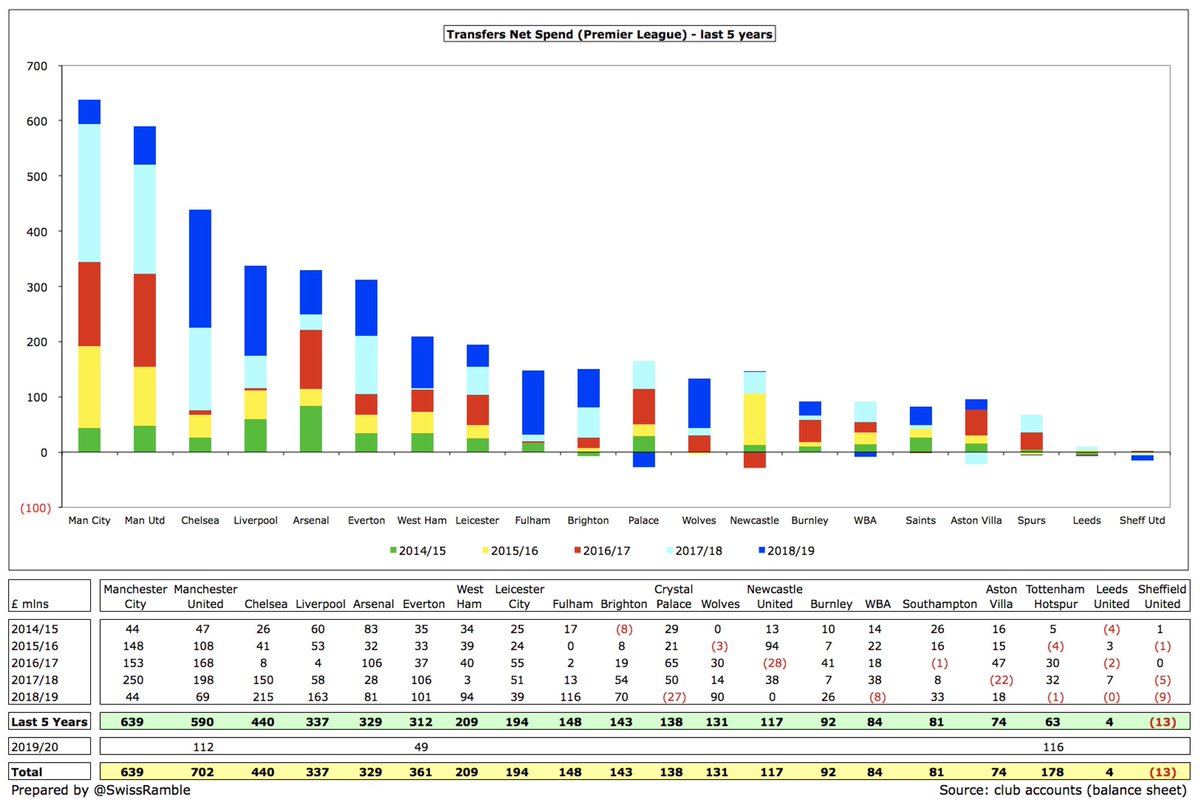Discover and read the best of Twitter Threads about #Swans
Most recents (22)
Nos vamos a Inglaterra. Juegan Manchester City vs. Liverpool. Sí, partidazo. Pero por acá queremos contarles la historia del clásico galés en Inglaterra. ¿Qué? Así es, por la jornada 39 de la #EFL Championship juegan Cardiff City y Swansea City. ¿Se suman? #Bluebirds #Swans 🏴 

scoutreportrb.com/post/scout-rep…
A contract expiring this summer and many championship clubs being linked. Read to find out why I think Kasumu could be an exciting player to recruit👀
RTs and Feedback massively appreciated
(Data viz below)
#Mkdons #Swans #BristolCity #htafc #ncfc
A contract expiring this summer and many championship clubs being linked. Read to find out why I think Kasumu could be an exciting player to recruit👀
RTs and Feedback massively appreciated
(Data viz below)
#Mkdons #Swans #BristolCity #htafc #ncfc
Swansea City’s 2020/21 accounts covered a season when they finished 4th in the Championship, thus reaching the play-offs, but were beaten in the final by Brentford. Head coach Steve Cooper since replaced by Russell Martin. Some thoughts in the following thread #Swans
#Swans swung from a pre-tax profit of £2.7m to a loss of £4.6m, as revenue fell £22m (45%) from £50m to £28m and profit from player sales dropped £5m (30%) to £12m, partly offset by total expenses reducing by £17m (26%) and £3.3m insurance claim. Loss after tax was £4.1m. 
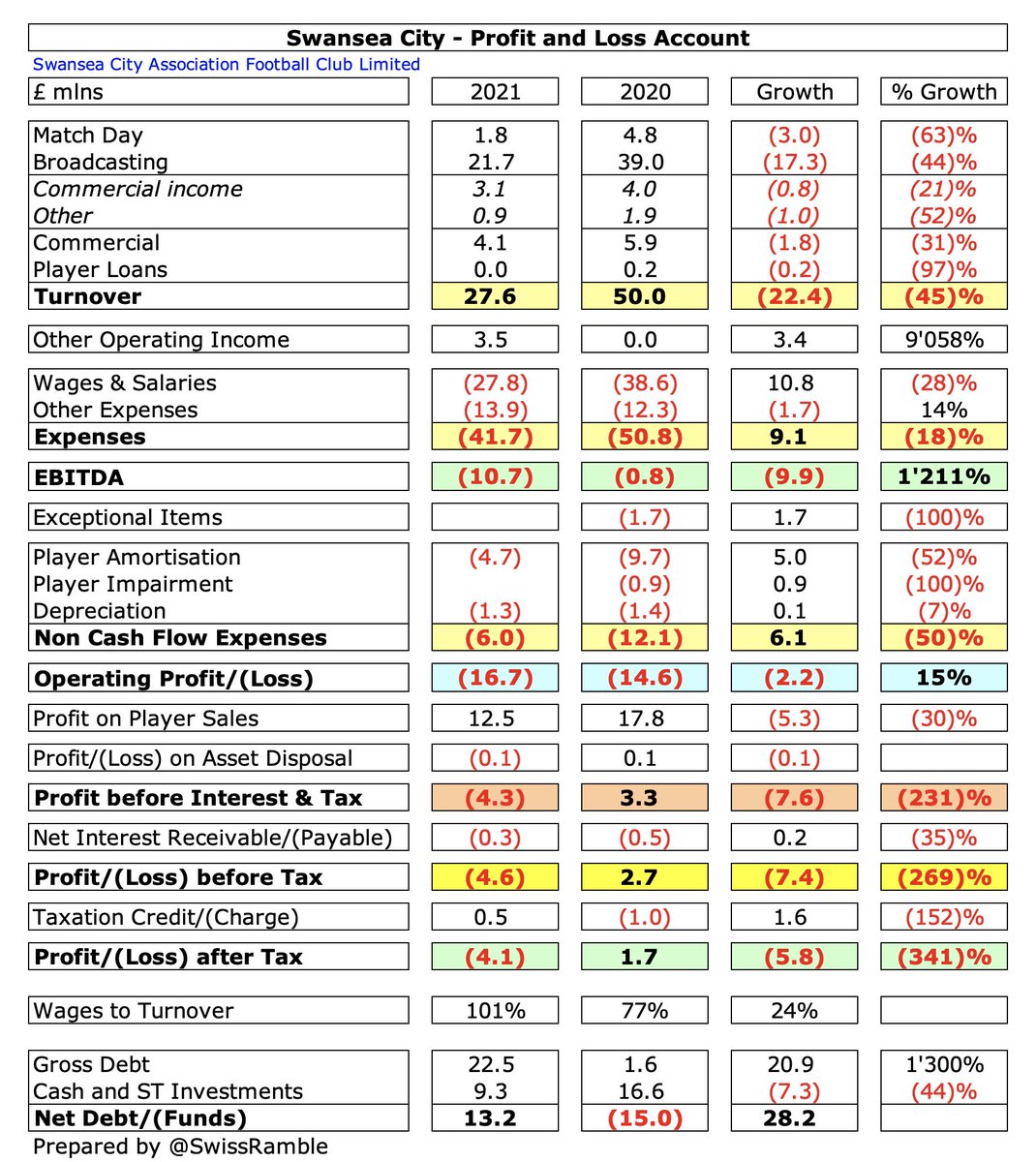
The main reason for #Swans £22m revenue decrease was broadcasting, which dropped £17m (44%) from £39m to £22m, mainly due to lower parachute payment, though COVID also drove reductions in match day, down £3.0m (63%) to £1.8m, and commercial, down £1.8m (31%) to £4.1m. 

At long last, it’s time for another #TetZoocryptomegathread, wherein I look in detail at a piece of photographic evidence said to show a MONSTER. This time, we’re looking again at a #LochNessMonster photo, specifically the HUGH GRAY PHOTO of 1933.... #LochNess #cryptozoology 



This photo - famously hard to interpret - is the very first photo claimed to show the Loch Ness Monster! And I’ll mostly be calling it the Gray Nessie photo. To business…
As per usual, please remember that this isn’t called a megathread for nothin. It’s loooooong. Secondly, I am an ‘honest sceptic’. I am not biased, and I aim to report authentically what authors and reporters have said, on both sides of the proverbial fence... #cryptozoology 

#CardiffCity 2019/20 accounts cover a season when they finished 5th in the Championship following relegation from the PL, losing in the play-off semi-final. Manager Neil Warnock was replaced by Neil Harris in November 2019, since succeeded by Mick McCarthy. Some thoughts follow.
#CardiffCity swung from £3m profit to £12m loss, as revenue fell £79m (63%) from £125m to £46m due to relegation and COVID, partly offset by profit on player sales rising £12m to £14m, while expenses were down £33m and no repeat of prior year £20m provision for the Sala transfer. 

#CardiffCity £79m revenue fall was largely driven by broadcasting’s £70m (66%) decrease from £107m to £37m, due to lower TV money in Championship, though commercial also dropped £5m (48%) from £10m to £5m and match day fell £4m (53%) from £8m to £4m. 

Stoke City’s 2019/20 financial results covered a season when they finished 15th in the Championship, two years after relegation from the Premier League. Manager Nathan Jones was replaced by Michael O’Neill in November 2019. Some thoughts in the following thread #SCFC
#SCFC pre-tax loss widened from £15m to £88m, as revenue dropped £21m (29%) from £71m to £50m and profit from player sales fell £15m (83%) from £18m to £3m. Total expenses increased £37m, mainly due to £43m impairment charge (reducing player values). Loss after tax was £86m. 

The main reason for #SCFC £21m revenue reduction was broadcasting, which dropped £20m (39%) from £51m to £31m, mainly due to lower parachute payment, though match day also fell £1.6m (25%) from £6.4m to £4.8m. In contrast, commercial rose £0.9m (7%) from £12.9m to £13.8m. 

#BarnsleyFC 2019/20 accounts covered the club’s first season back in the Championship following promotion from League One, when they narrowly avoided relegation by finishing 21st. Head coach Daniel Stendel was replaced by Gerhard Struber, since succeeded by Valerien Ismael.
#BarnsleyFC are owned by a group of international investors, led by Chien Lee of NewCity Capital and Paul Conway of Pacific Media Group, who follow the “Moneyball” approach of fellow investor, Billy Beane. They bought 80% from former custodian, Patrick Cryne, in December 2017.
Following promotion to the Championship, #BarnsleyFC reduced their loss from £3.4m to just £0.3m, as revenue increased £6.4m (83%) from £7.8m to £14.2m and profit on player sales rose £2.0m to £5.8m, partly offset by expenses growing £5.6m (37%) to £20.5m. 

Queens Park Rangers 2019/20 financial results covered a season when they finished 13th in the Championship, an improvement on the previous year’s 19th place, though the campaign was disrupted by COVID-19. Some thoughts in the following thread #QPR
#QPR loss widened from £10m to £16m, as revenue fell £16m (47%) from £34m to £18m, though expenses were cut £11m (24%) and profit on player sales increased £3m to £6m. Also impacted by £4.5m write-off of previous training ground development. 
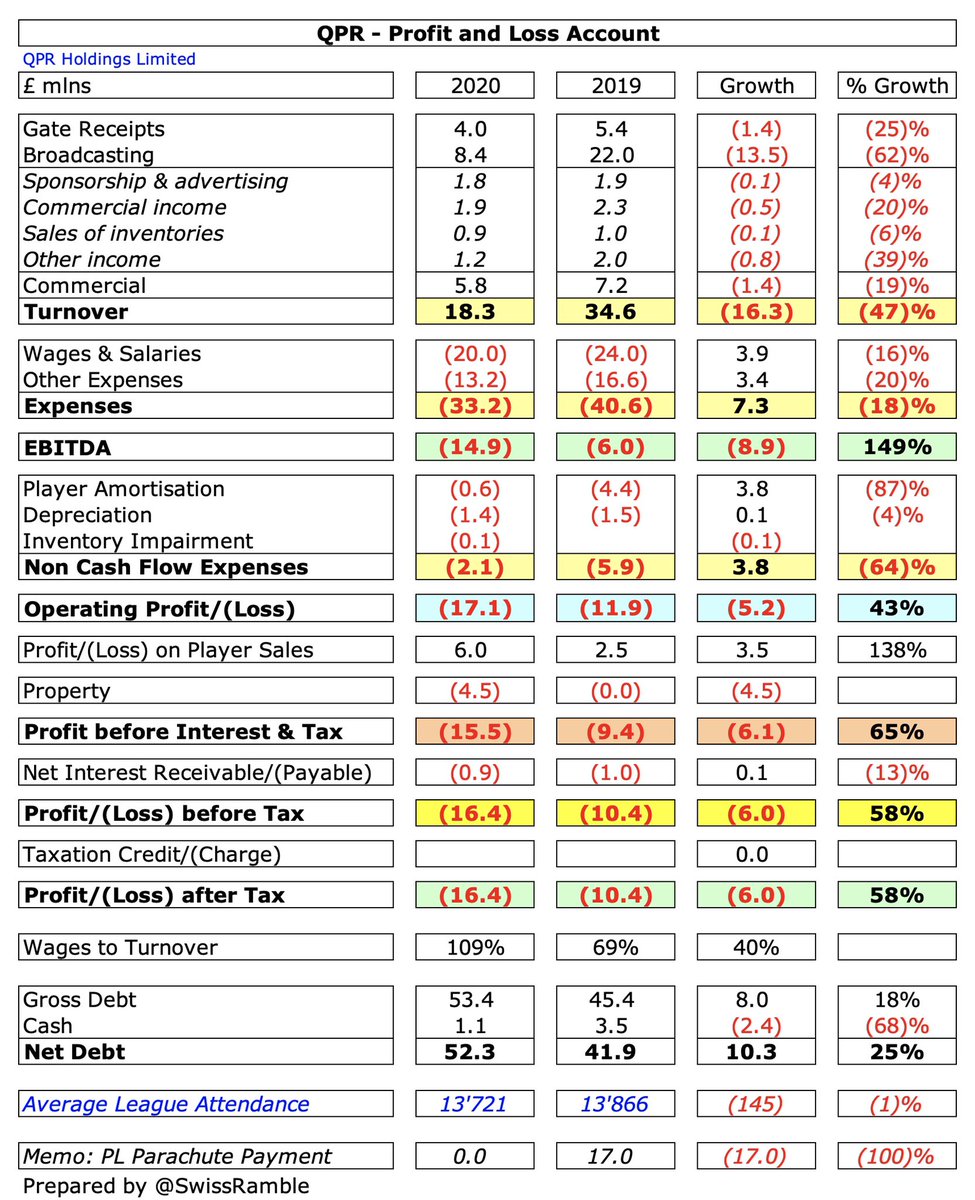
The main reason for #QPR £16m revenue reduction was broadcasting, which dropped £14m (62%) from £22m to £8m, as parachute payments stopped, though gate receipts were also down £1.4m (25%) from £5.4m to £4.0m, while commercial fell £1.4m (19%) from £7.2m to £5.8m. 

Swansea City’s 2019/20 accounts covered a season when they finished 6th in the Championship under head coach Steve Cooper, thus reaching the play-offs, but were eliminated in the semi-final by Brentford. Some thoughts in the following thread #Swans
#Swans swung from a pre-tax loss of £7m to a profit of £2.7m, despite revenue falling £18m (27%) from £68m to £50m and profit from player sales dropping £12m (41%) from £30m to £18m, as total expenses were reduced by £40m (38%). Profit after tax was £1.7m. 
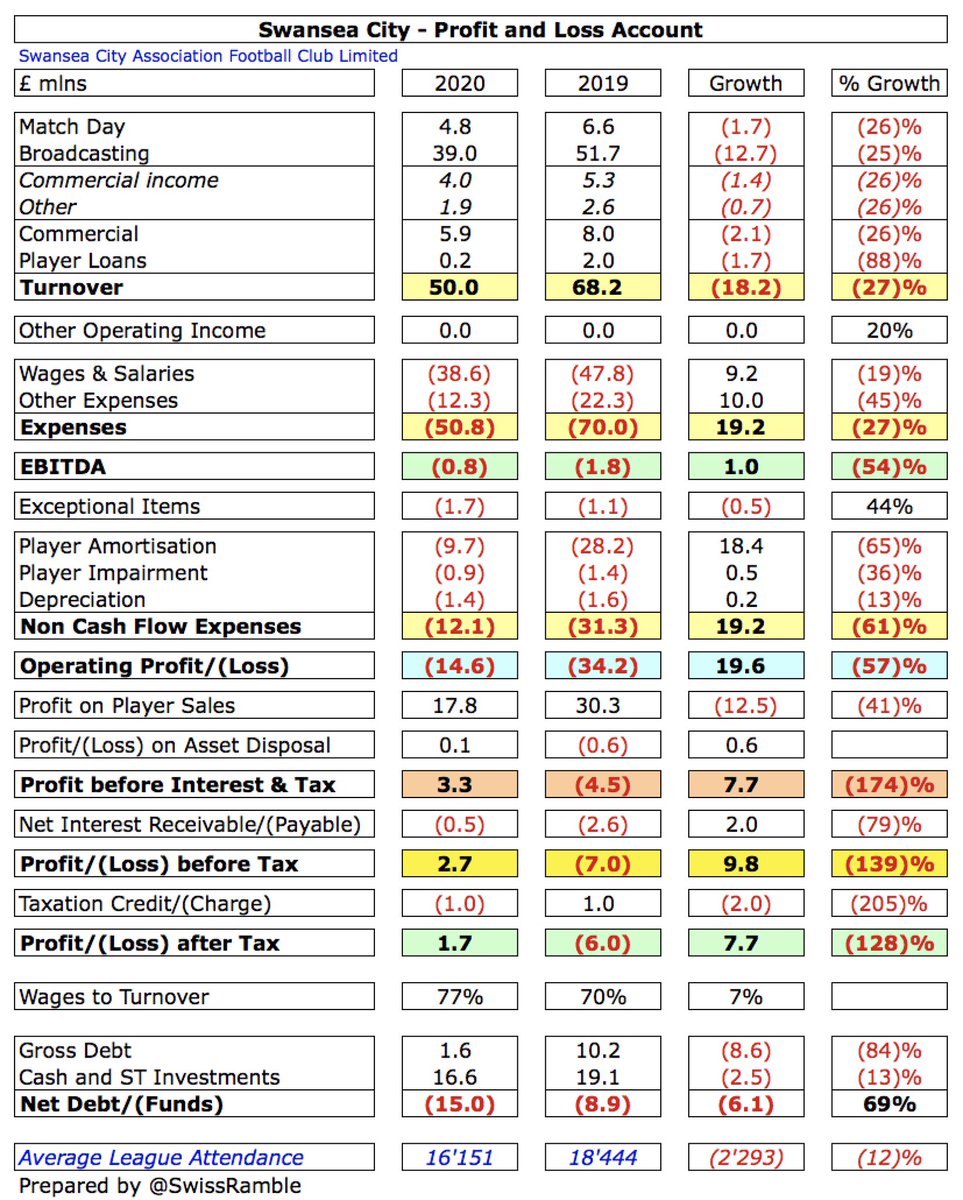
The main reason for #Swans £18m revenue reduction was broadcasting, which dropped £13m (25%) from £52m to £39m, mainly due to lower parachute payment, though commercial was also down £2m (26%) to £6m and match day fell £1.7m (26%) to £4.8m. Player loans were down £1.7m to £0.2m. 

Birmingham City’s 2019/20 financial results covered a season when they finished 20th in the Championship, narrowly avoiding relegation. Manager pep Clotet was replaced by Aitor Karanka in August 2020, since succeeded by Lee Bowyer. Some thoughts in the following thread #BCFC
#BCFC loss increased from £8.4m to £18.2m, as prior year included £17m profit on the sale of the stadium, partly offset by profit on player sales rising £7m to £12m. Revenue fell £0.5m (2%) from £23.3m to £22.8m, while expenses were flat overall. 
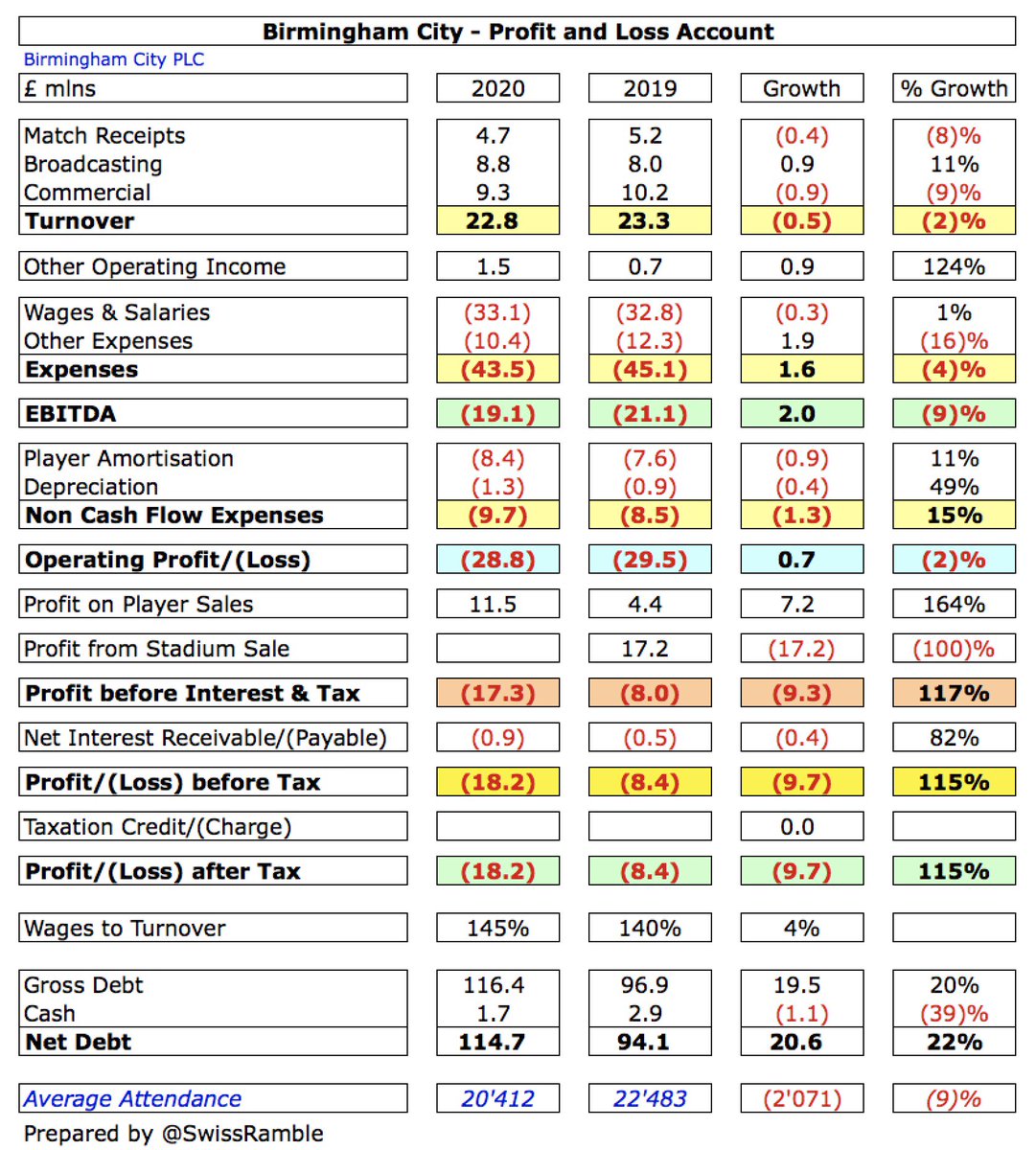
COVID-19 impacted #BCFC revenue with match receipts falling £0.4m (8%) to £4.7m, while commercial was down £0.9m (9%) to £9.3m. In contrast, broadcasting rose £0.9m (11%) to £8.8m, while other operating income increased £0.9m to £1.5m, including £819k COVID grant. 

#BristolCity 2019/20 financial results cover a season when they finished 12th in the Championship. Head coach Lee Johnson was replaced by Dean Holden in July 2020. Finances were impacted by COVID-19. Some thoughts in the following thread.
#BristolCity swung from £11m profit before tax to £10m loss, mainly due to profit on player sales falling £12m from £38m to £26m, while revenue dropped £3m (10%) from £30m to £27m and expenses rose £6m (10%) to £64m. After tax, £10m profit to £9m loss. 
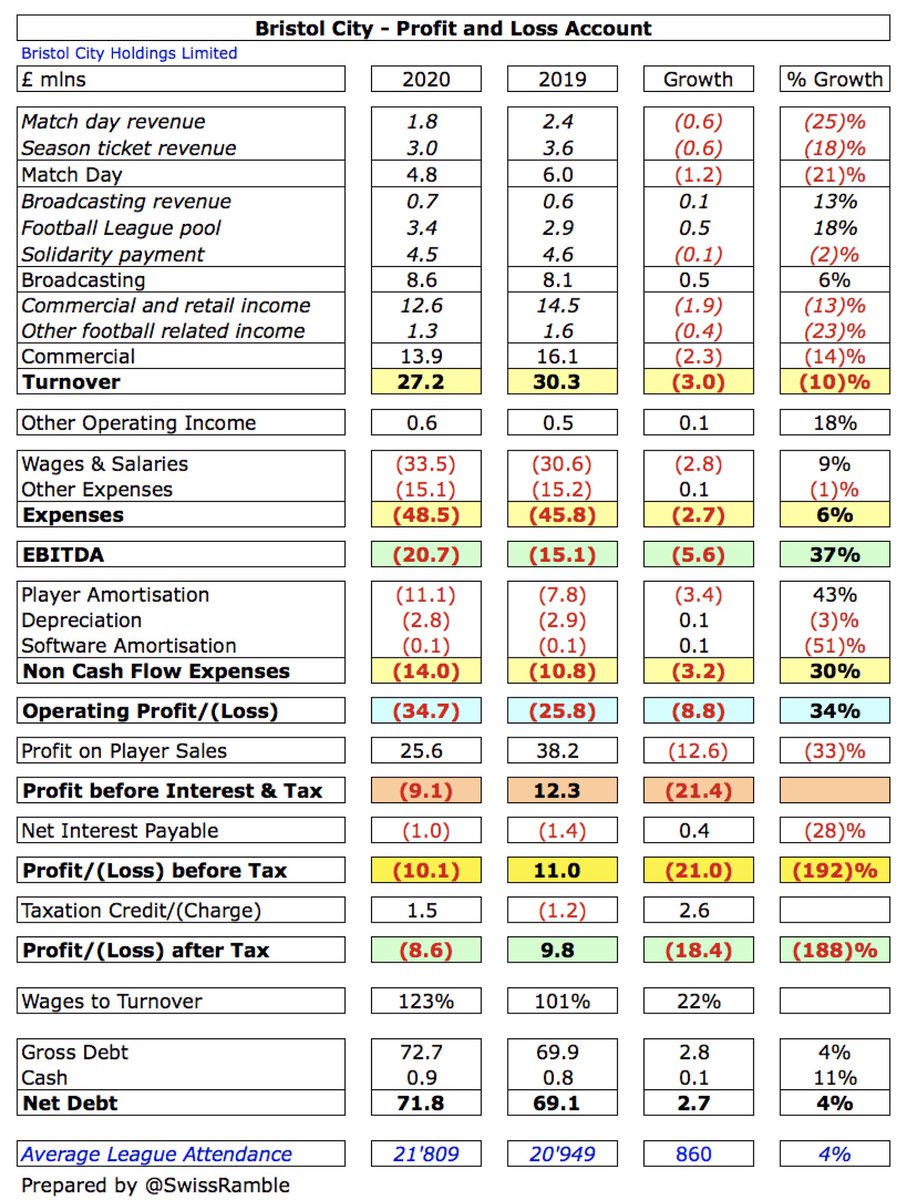
#BristolCity revenue decrease was mainly driven by commercial falling £2.3m (14%) to £13.9m, though match day also dropped £1.2m (21%) to £4.8m, as 5 games were played behind closed doors. On the other hand, broadcasting increased £0.5m (6%) to £8.6m. 
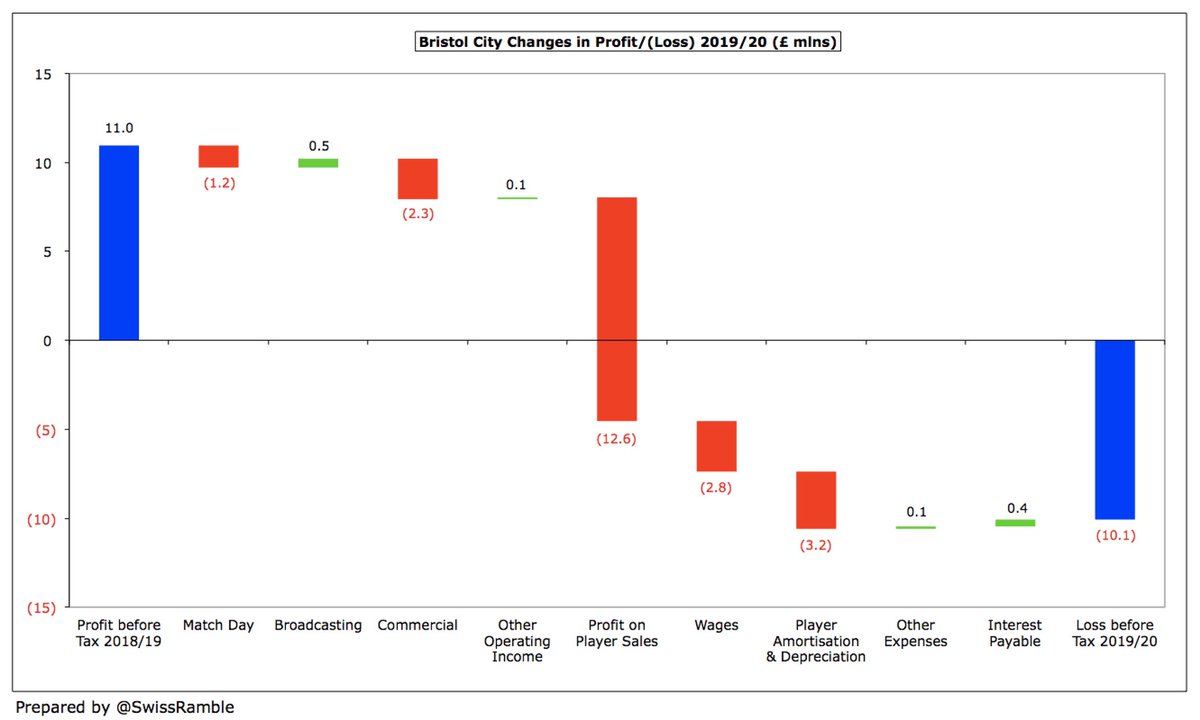
I had a request to look at transfer spend in the Premier League, so I have analysed this over the last 5 years (up to 2018/19, the last season when all clubs have published their accounts). As a Christmas bonus, I have also included the EFL Championship.
I had a few requests to prepare some more financial fact sheets for: (a) the two major Scottish clubs, namely Celtic and Rangers; (b) and Swansea City. Hope you find them useful #CelticFC #RangersFC #Swans
#CelticFC have been profitable for the last 4 years, helped by good profits from player sales. Revenue fell in 2019, due to not qualifying for Champions League group stage. Low debt, high cash balance, declining net transfer spend. Highest revenue, wages and profit in Scotland. 

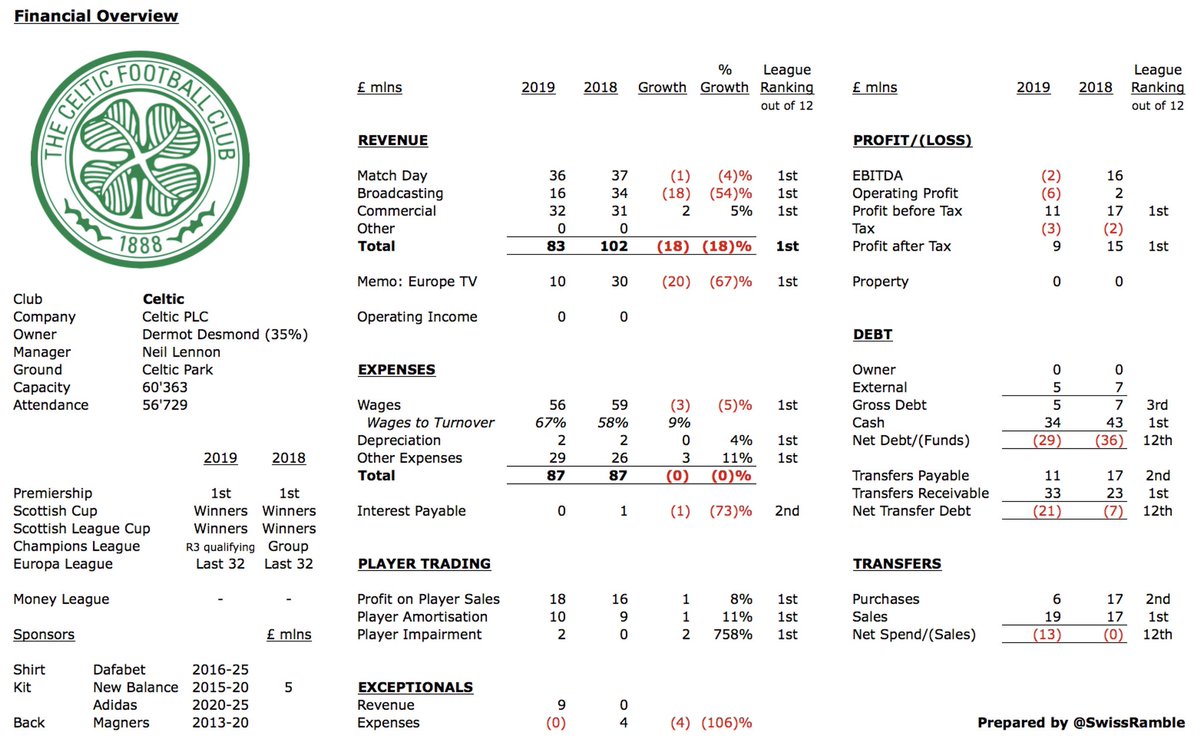
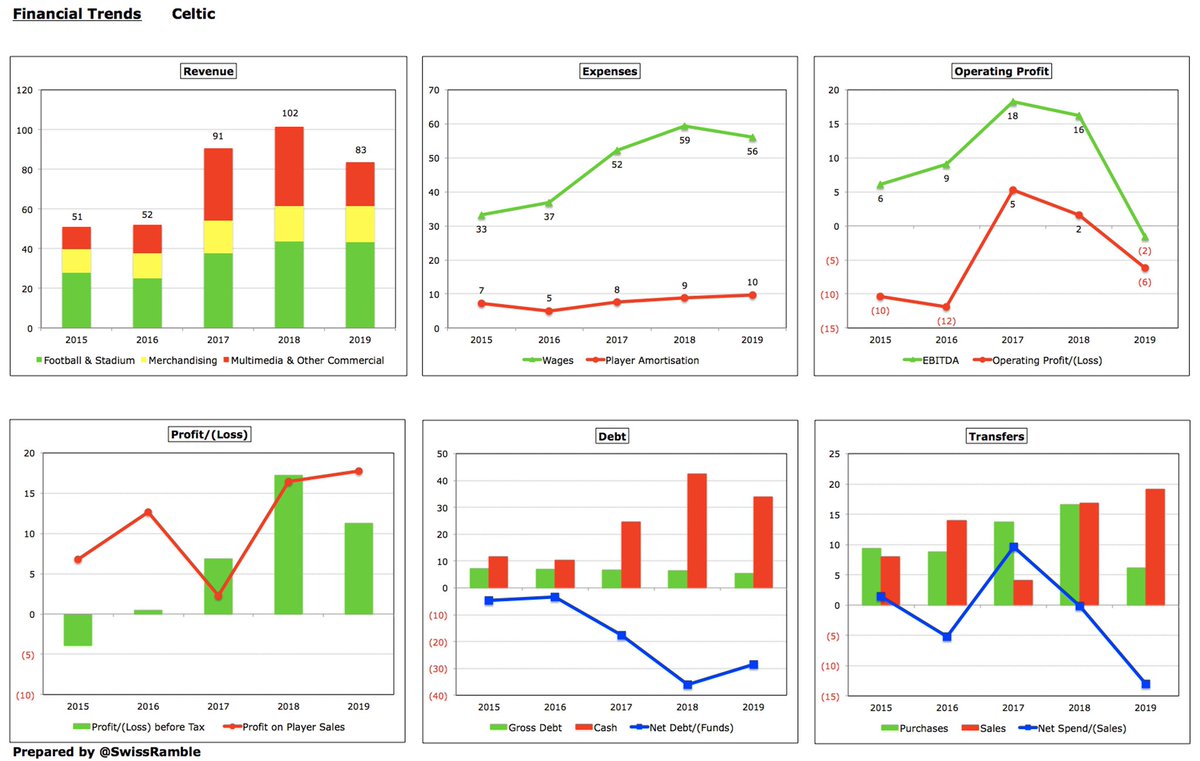
#RangersFC have lost money in last 5 years, partly due to low profits from player sales. However, revenue has more than tripled since 2015, driven by improved performance in Europe. Largest loss, debt and transfer spend in Scotland in 2019. Wages up to £34m (65% of turnover). 

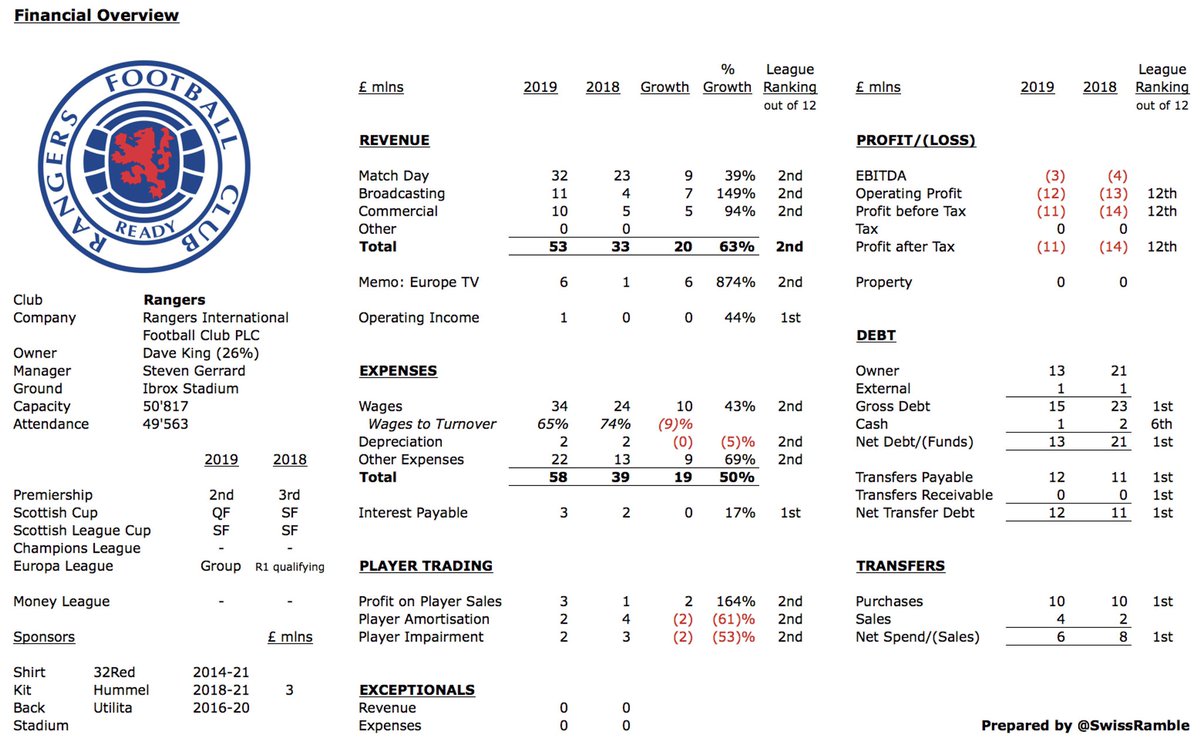
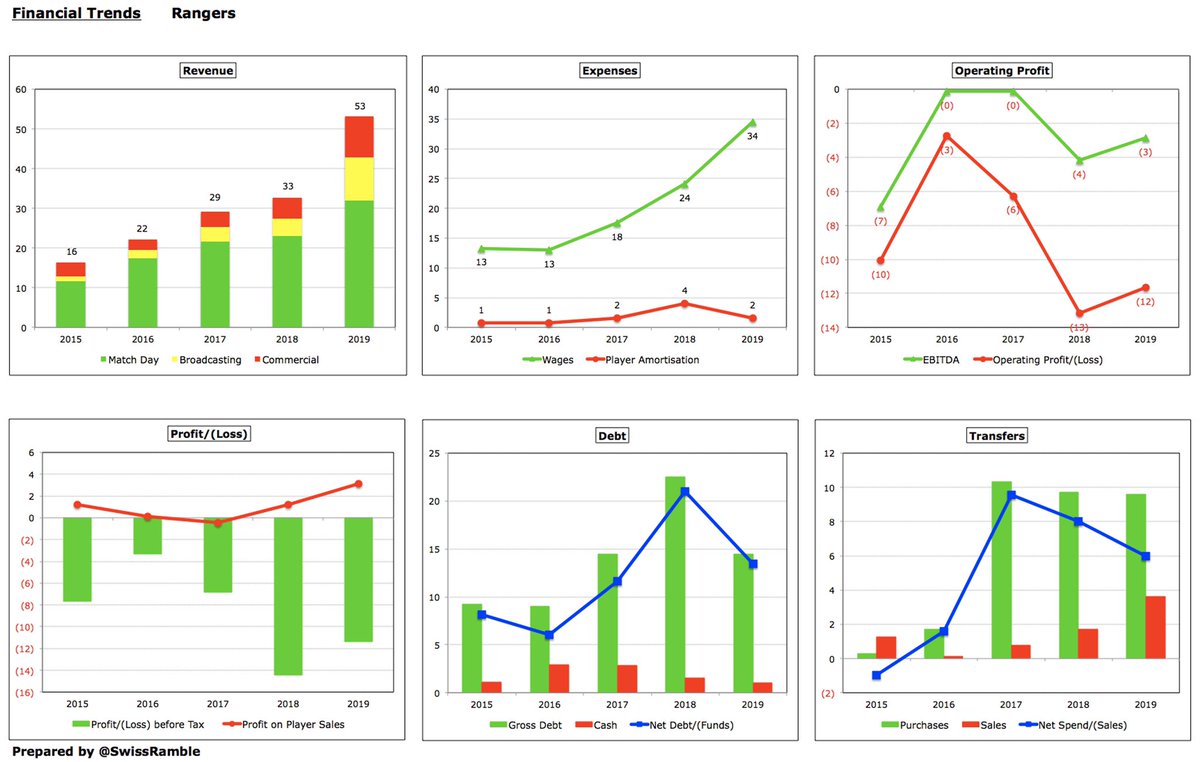
Swansea City’s 2018/19 accounts covered a challenging season when they finished a respectable 10th in the Championship following relegation after 7 years in the Premier League. Manager Graham Potter left for #BHAFC in May ‘19, replaced by Steve Cooper. Some thoughts follow #Swans
#Swans loss before tax widened from £3.2m to £7.0m, as revenue almost halved following relegation from £127m to £68m, despite parachute payments, and profit on player sales fell £16m to £30m, largely offset by cutting costs by £72m. After tax, loss increased from £2.9m to £6.0m. 

The main reason for #Swans £59m (46%) revenue reduction was broadcasting, which more than halved in the Championship from £105m to £52m, though commercial was also down £6m (45%) to £8m and match day fell £0.8m (11%) to £6.6m. Player loans up £1.7m to £2.0m. 
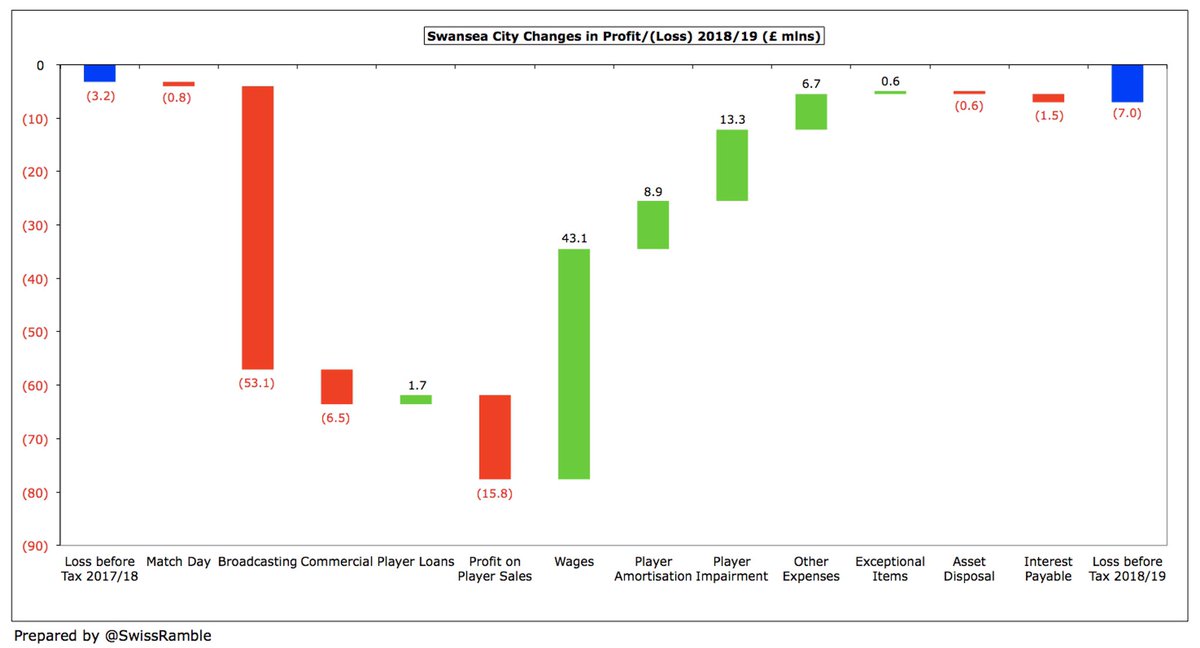
#BristolCity recently published their 2018/19 financial results, covering a season when they finished 8th in the Championship, their highest position for 11 seasons and just 4 points off a play-off position. Some thoughts in the following thread.
#BristolCity reported £11m profit before tax, a significant improvement on the prior season’s £25m loss, mainly thanks to profit on player sales surging from hardly anything in 2017/18 to £38m last season. Owner Steve Lansdown described the results as “a milestone” for the club. 
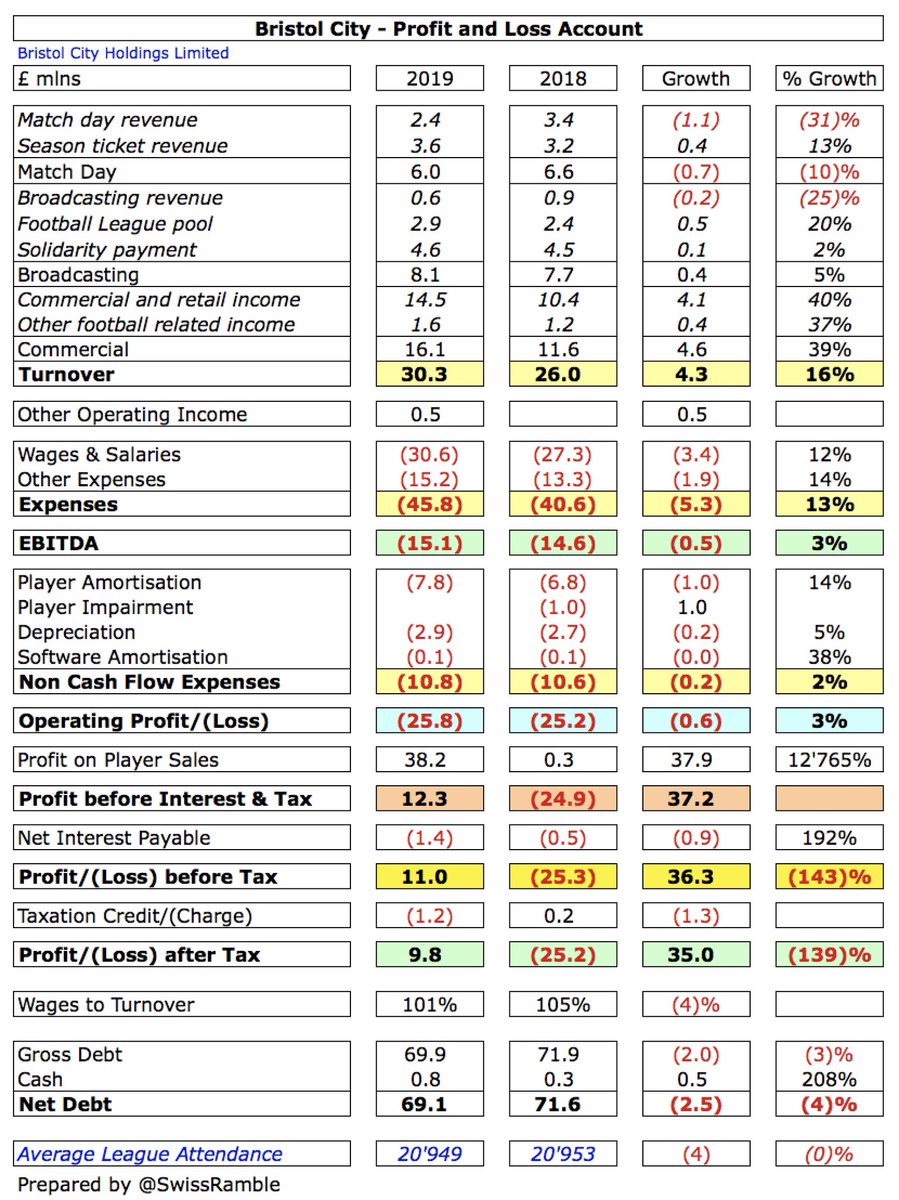
#BristolCity revenue also rose by £4m (16%) from £26m to £30m, mainly due to commercial income increasing £4.6m (39%) to £16.1m, though broadcasting was also up £0.4m (5%) to £8.1m. On the other hand, match day income fell £0.7m (10%) to £6.0m. 
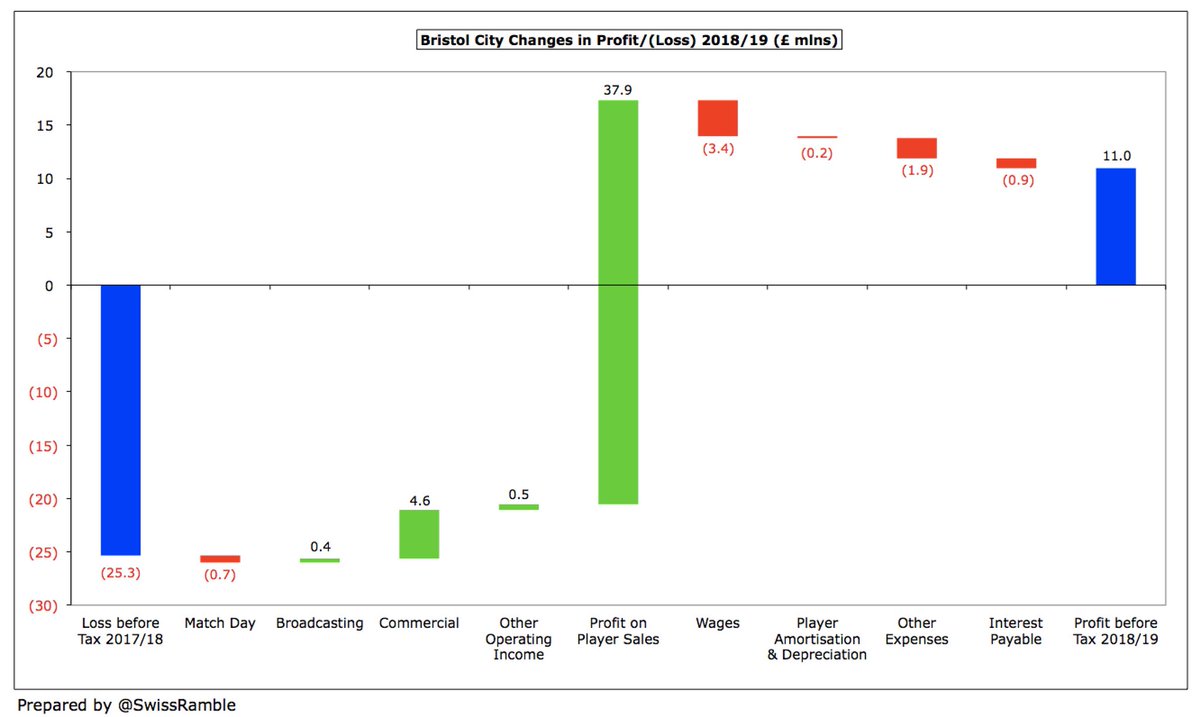
Hull City’s 2018/19 financial results covered a season when they finished 13th in the Championship. Manager Ian Adkins resigned in June, replaced by Grant McCann. The owners, Assem and Ehab Allam, have been looking to sell the club for some time. Some thoughts follow #hcafc
#hcafc profit before tax decreased from £24m to £3m, mainly due to profit on player sales falling by £26m from £31m to £5m. Revenue was down £7m (13%) to £48m, because of lower parachute payments. Partly compensated by expenses being cut by £12m. 
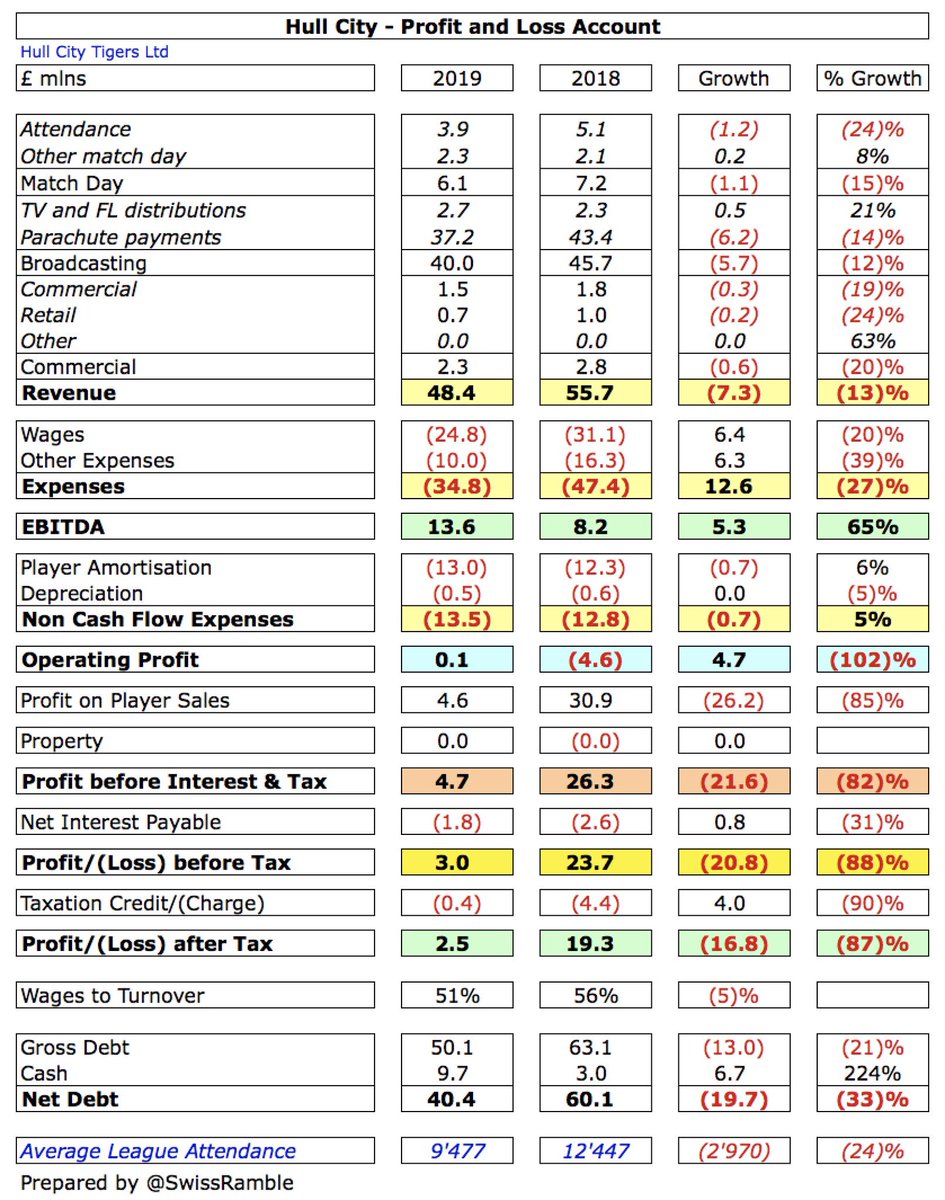
The main driver of #hcafc £7m revenue reduction was a £6m cut in parachute payments from the Premier League from £43m to £37m, but the other revenue streams also declined: match day was down £1.1m (15%) to £6.1m, while commercial was £0.6m (20%) lower at £2.3m. 
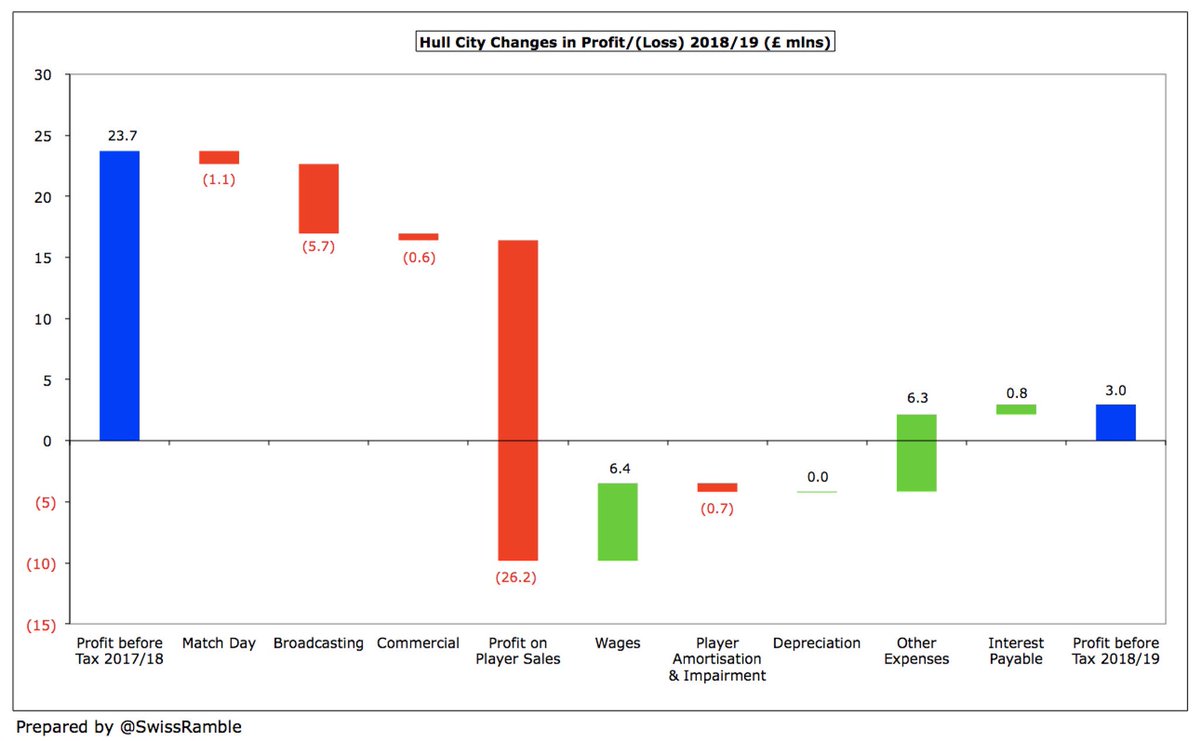
A previous thread explained the differences between a football club’s profit and loss account and its cash flow statement, as it is important to understand where the money has been spent. This thread will look at how this works for each of the 20 Premier League clubs in 2017/18.
#AFC went from £52m operating profit to £42m operating loss, due to lower revenue after failing to qualify for the Champions League, compounded by higher wages and player amortisation plus Wenger pay-off. However, £120m profit on player sales resulted in £70m profit before tax. 
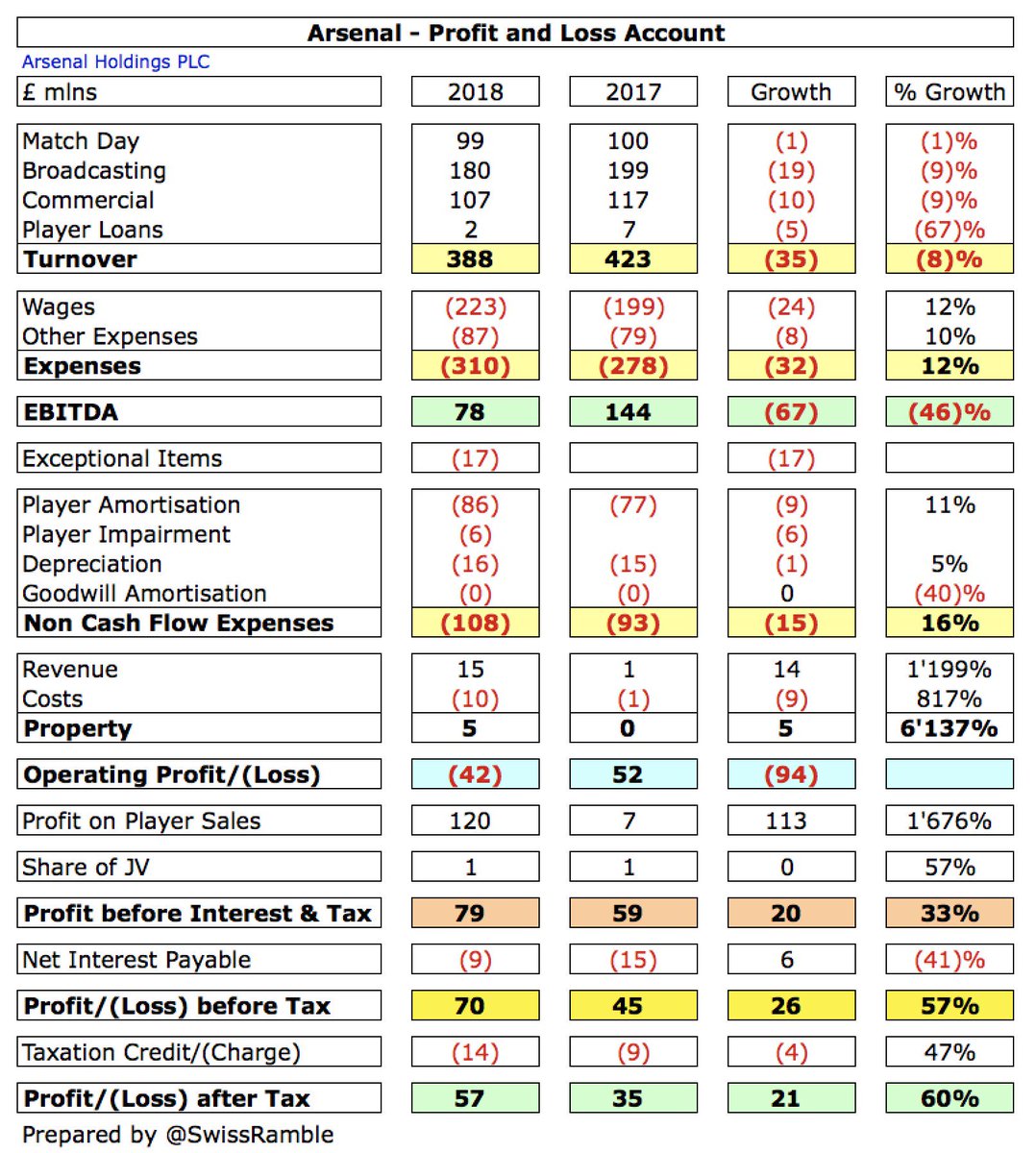
#AFC cash flow boosted by favourable £58m movement in working capital (increase in creditors). Spent £29m (net) on players (purchases £110m, sales £81m). Paid £20m for Emirates loan (£11m interest & £9m debt) plus £12m tax. Net cash inflow of £51m was highest in Premier League. 
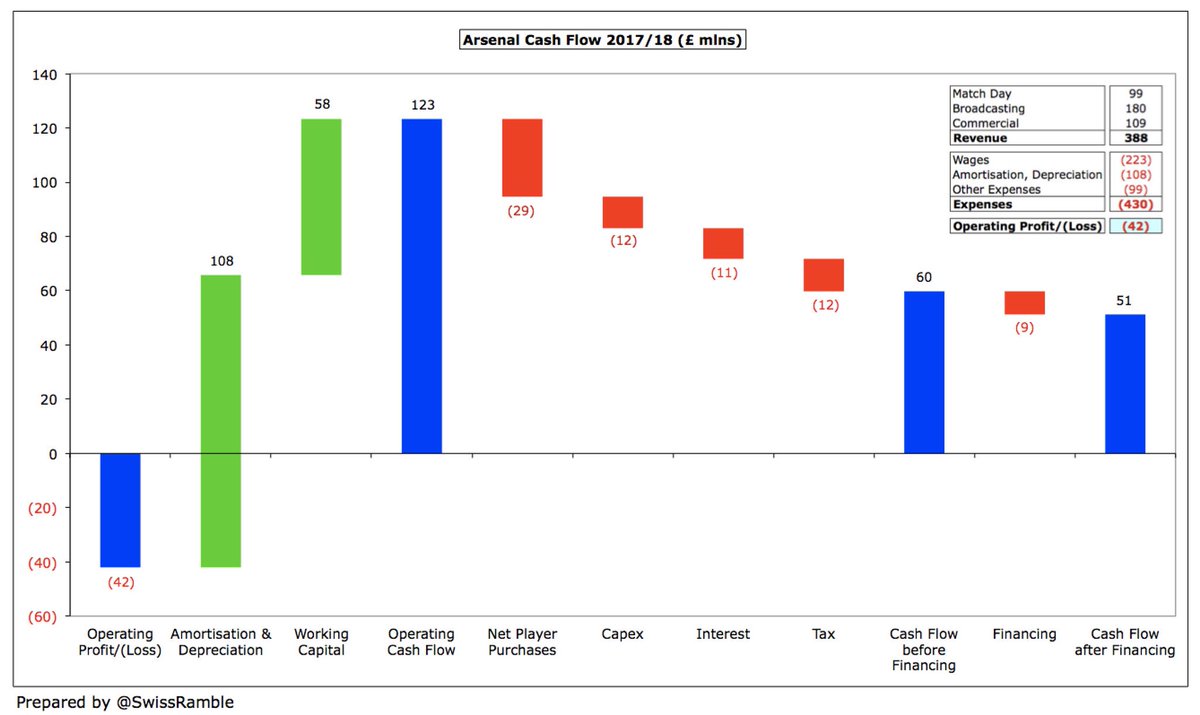
One of the questions most frequently asked by football fans is “Where’s all the money gone?” The answer is only partly found in a club’s profit and loss account, so we need to also look at the cash flow statement to get the full picture. Some thoughts in the following thread.
A club’s profit and loss account is easy to understand, as it is basically revenue less expenses (mainly player wages), but this is an accounting profit based on the accruals concept, which can be very different from actual cash movements.
This is important, as the main reason that football clubs fail is cash flow problems. It does not matter how large your revenue is (or your profits are), if you do not have the cash to pay your players, suppliers or indeed the taxman, then you will find yourself in trouble.
#TetZooCon 2019: a thread. We've over the half-way mark as goes filling up the venue, and it's only early September. TetZooCon is being held at University of London's THE VENUE, Malet St, #London, Oct 19th & 20th. Around 18 talks, an art exhibition, 3 discussions, stalls, merch.. 

Book places here (we don't send paper tickets)... this is also where you book for the conference meal and the (separate) #palaeoart workshop (which currently runs in parallel to part of the main event, alas): tetzoo.com/convention
#TetZooCon 2019 includes a special session on natural history film-making, with a talk from Amber Eames (on her #swans film) and an on-stage discussion and Q&A with Paul Stewart, Nick Lyon and Zoe Cousins... 




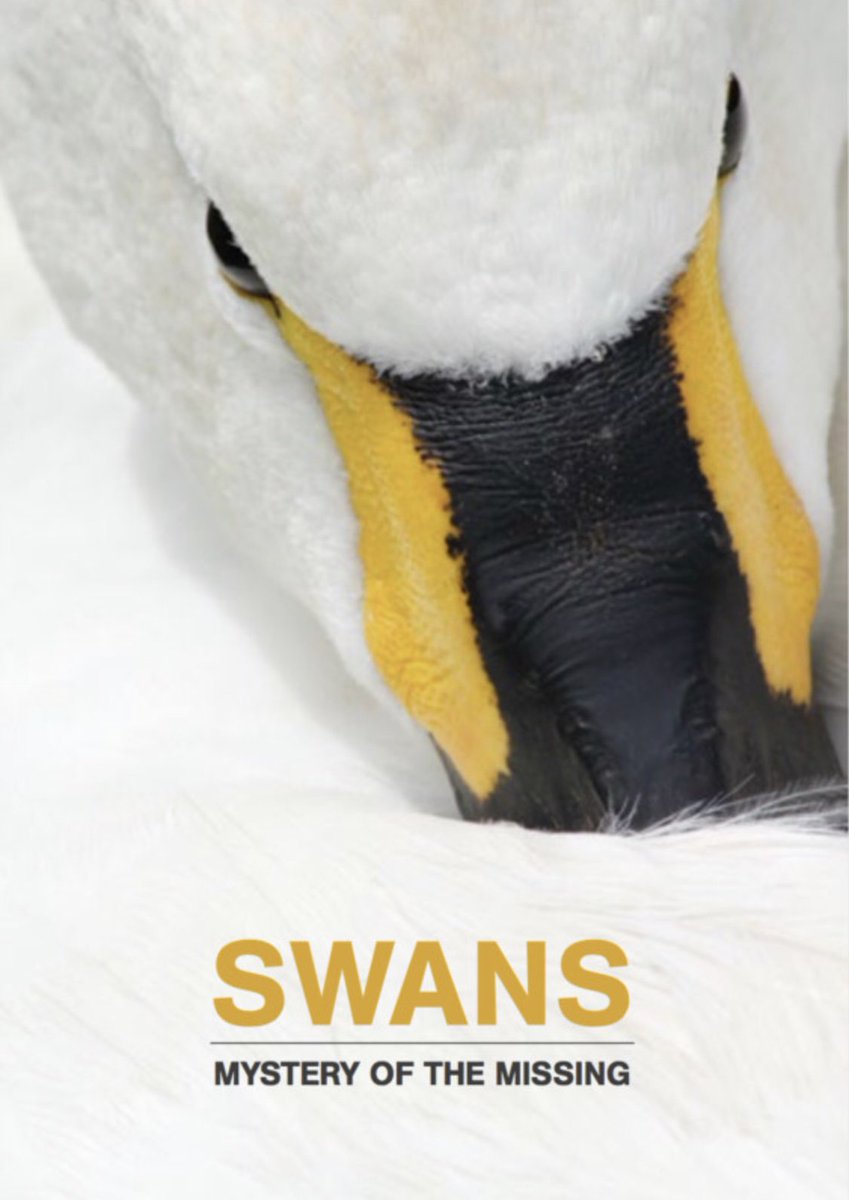
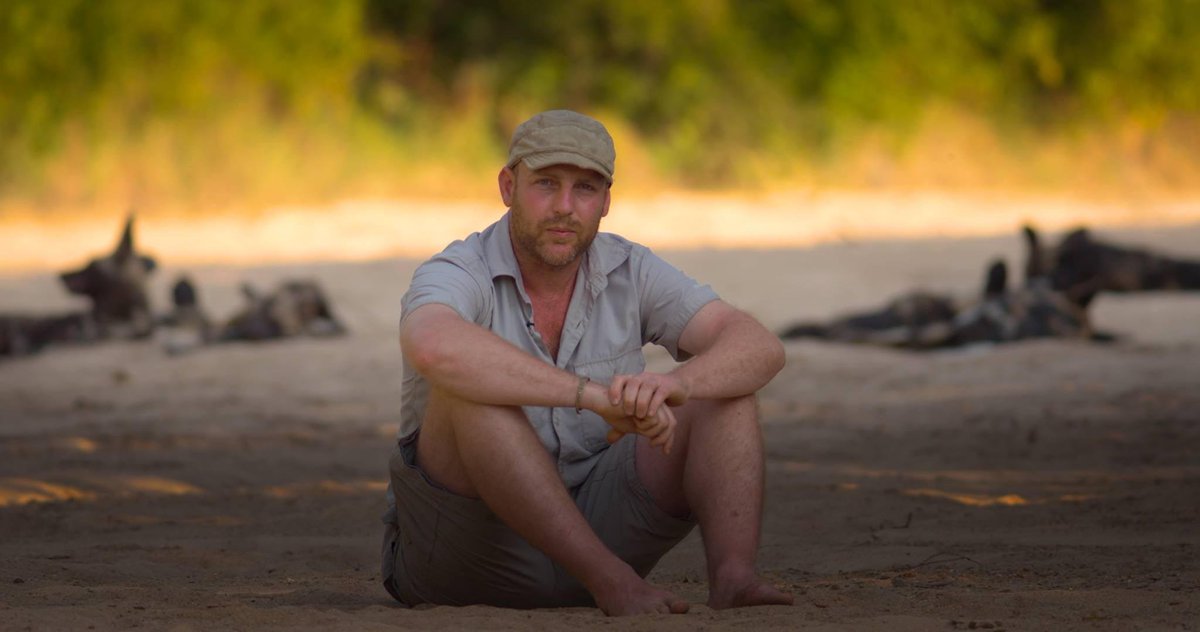

Swansea City’s 2017/18 financial results covered a “difficult” season when they finished 18th, so were relegated to the Championship after 7 consecutive years in the Premier League. They had 3 managers: Paul Clement, Carlos Carvahal and Graham Potter. Some thoughts follow #Swans
#Swans made a loss before tax of £3.2m, compared to a prior year profit of £13.4m, representing a £16.6m deterioration, as revenue fell £1m from £128m to £127m, though profit on player sales was up £9m to £46m. After tax, the club went from a £13.0m profit to a £2.9m loss. 
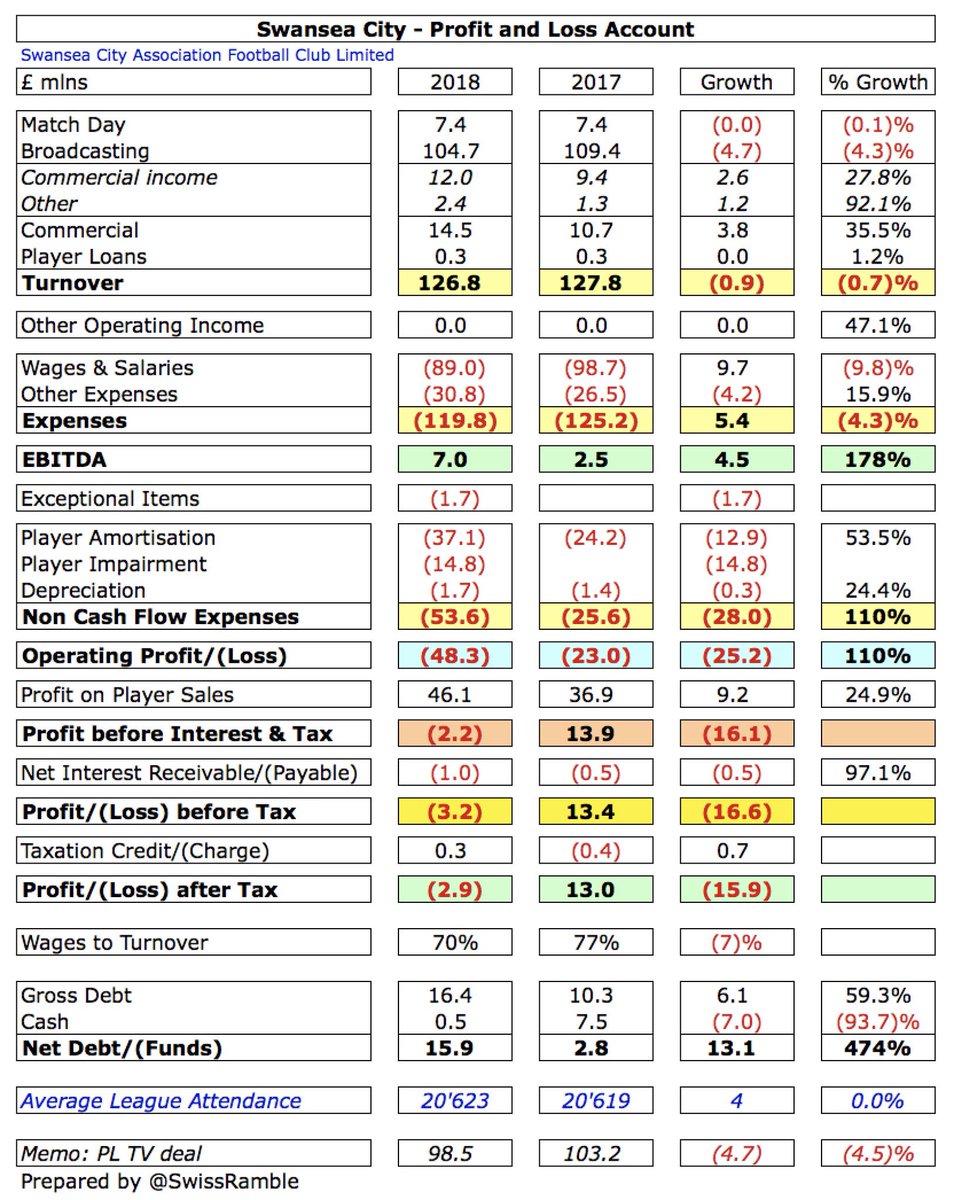
#Swans £1m revenue fall was very largely driven by broadcasting’s £4.7m (4%) decrease from £109.4m to £104.7m, due to less prize money for a lower league position. In contrast, commercial rose £3.8m (35%) from £10.7m to £14.5m, while match day was flat at £7.4m. 
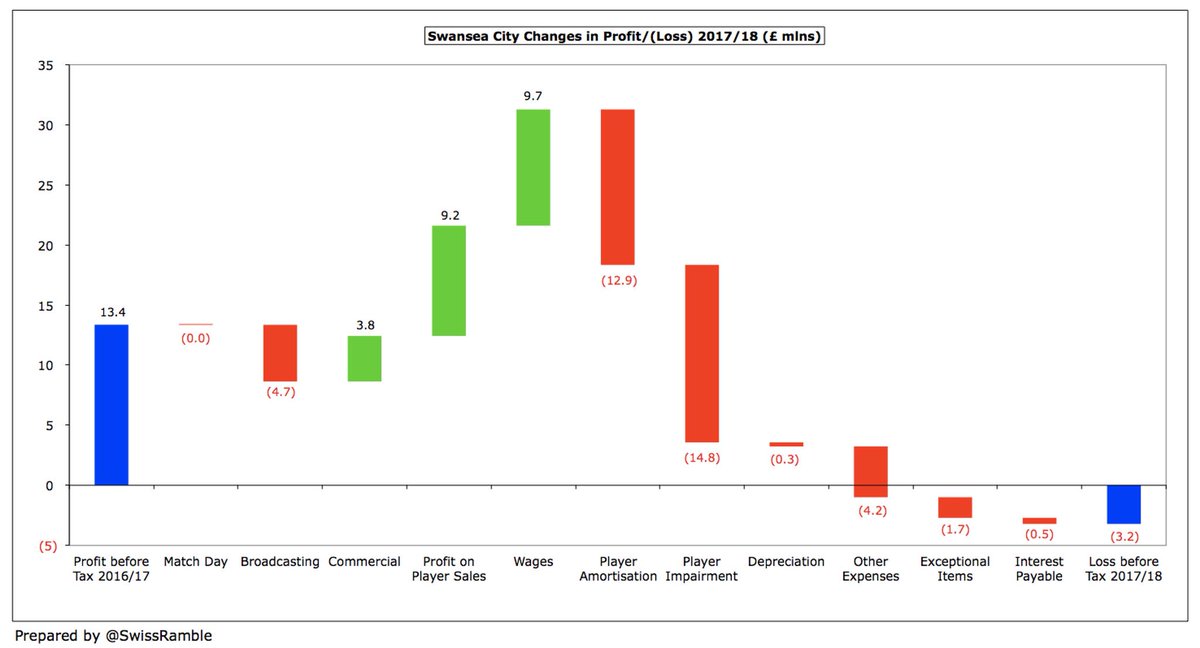
Following my recent analyses of where Premier League and Championship clubs source their money and what they spend it on, I received many questions on how a cash flow statement works, so I will explain the mechanics (using Premier League season 2016/17) in the following thread.
Traditionally, supporters have focused on a club’s profit and loss account, which is not surprising, because: (a) that is what the media tend to report; (b) it is intuitively easy to understand, being basically revenue less expenses (mainly player wages).
Nevertheless, the reported figure is an accounting profit, which is not necessarily a “real” cash profit, as it is based on the accountant’s accruals concept and this can be very different from actual cash movements.
Although the 2016/17 financial results for the Premier League are now a season out-of-date, they are still the most recent published by the clubs, so I thought some comparisons might be interesting as we head into the 2017/18 season. Thread follows.







